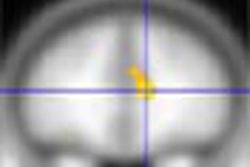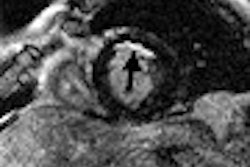VIENNA - Dendrimers -- those dynamic yet well-defined globular macromolecules underlying a new generation of MR contrast agents -- are producing impressive results in patients. One such agent currently in clinical trials, Gadomer-17, produced dramatic improvements in 3-D MR coronary angiography studies, according to a presentation at this week’s European Congress of Radiology.
Dr. Jörg Barkhausen from the department of radiology at University Hospital in Essen, Germany discussed his group’s use of the intravascular contrast agent for the detection of coronary artery stenosis in 12 patients.
"The purpose of our study was to assess the safety and efficacy of this contrast agent in patients with angiographically proven coronary artery disease," Barkhausen said. "We compared different techniques for our breathhold in coronary angiography.
The group tried out a variety of MR techniques such as TrueFISP, he said, but image quality was poor compared to the final choice: a turboFLASH technique that appeared to optimize enhancement using the investigative agent.
As for Gadomer-17, its large molecules prevent distribution to the extravascular space, and also serve to slow renal excretion. The blood pool agent maintains its effectiveness for about 30 minutes after injection of a single dose, and its relaxivity is about 45 times higher than standard gadolinium-based contrast, Barkhausen said.
All of the patients underwent MR coronary angiography twice on a 1.5-tesla Magnetom Sonata scanner (Siemens Medical Solutions, Erlangen, Germany). First they had unenhanced MR coronary angiography (TR/TE 3.8/1.6 ms, FA of 65º, and a matrix 512 x 512 mm).
"We used a steady-state free precession sequence to display the movement of the coronary arteries during the cardiac cycle," he said.
Following injection of 1.1 mmol/kg of Gadomer-17 (Schering AG, Berlin), a second set of images was obtained in each patient using a 3-D inversion recovery turboFLASH sequence (TR/TE 5.8/2.2 ms, FA of 25, and a matrix of 512 x 512 mm).
"We calculated the time course for blood-over-myocardium contrast," he said. "Image quality was graded on a four-point scale (1 was nondiagnostic, 4 was maximum) … and we looked for the accuracy of detection of coronary artery stenosis." Finally, catheter angiography and MR coronary angiography of the main coronary artery, proximal and middle left anterior descending coronary artery (LAD), proximal coronary artery (CA), and proximal and middle right coronary artery (RCA) were compared segment-by-segment, Barkhausen said.
"If you compare signal-to-noise and contrast-to-noise ratios prior to contrast injection and postcontrast-injection, there was no significant difference. However, contrast-to-noise ratio dramatically improved (200%, p< 0.05) in the post-contrast images," he added.
Overall image quality for the 72 segments examined improved from 2.0 ± 0.9 to 2.9 ± 0.9 on the contrast-enhanced scans.
"This is the most important finding: The number of nondiagnostic segments decreased from 38% to 10% for the post-contrast scans," he said. And sensitivity increased from 80% to 93% pre- and postcontrast injection for the detection of significant stenoses for the 62% of all segments that could be evaluated in both techniques.
"If we compare Gadomer-17 enhanced coronary angio with the trueFISP technique, we are going to see improved contrast-to-noise ratio," Barkhausen said. "Compared to standard contrast agents ... we have the ability to (insert) multiple stents after a single dose of contrast, and we can even use navigator stents ...According to our initial experience, (Gadomer-17) will make further evaluation of the patency of coronary arteries easier."
By Eric BarnesAuntMinnie.com staff writer
March 11, 2003
Related Reading
Artifact-free MRA renders metallic stents invisible, March 9, 2003
Epix contrast agent clears second phase III trial, March 8, 2003
Cardiac MR reveals evidence of subendocardial ischemia in syndrome X, July 22, 2002
Contrast agents herald new progress in MR lymphography, August 9, 2002
Copyright © 2003 AuntMinnie.com



.fFmgij6Hin.png?auto=compress%2Cformat&fit=crop&h=100&q=70&w=100)




.fFmgij6Hin.png?auto=compress%2Cformat&fit=crop&h=167&q=70&w=250)











